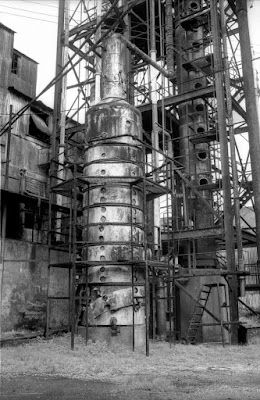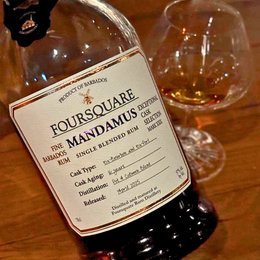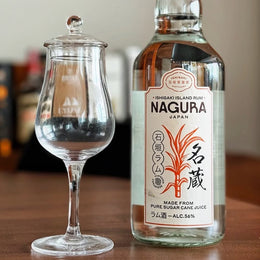Caroni 1998, 24 Year Old, “Chaconia” from the Floral Rum Series, bottled by Distilia for Catawiki, 60.2% ABV

I’ve written several reviews now about how there is a sort of divide when it comes to rums – heavy style versus light style. Readers have put up with my persistent gripes about how there is an overt obsession with the heavy styled ester bombs, and have consistently slept on the lighter styled stuff, particularly the rhum agricoles.
I should make clear that this divide is a false dichotomy – distilleries themselves produce various styles, light to heavy, or more technically known as marques, so as to arm themselves with a variety of components that go into a spectrum of blends that ultimately looks to serve an array of palates and end uses, from the straight sippers to the daiquiri workhorses. Seldom do distilleries focus on producing just one style of distillate, so why should we on the other hand do so? Or so I’ve waxed lyrical.

An intense gravitation towards dressing distillates over all else. (Image Source: McTear's Auctioneers)
Interestingly this dichotomy shares parallels when it comes to whiskies, with the whisky world gravitating towards the Port Ellen’s and Brora’s, which were dressing malts that were added in small proportion to increase the flavor of blends.
I get the appeal, why focus on the “less flavorful” stuff that forms the bulk of blends that ends up needing the assistance of the more “intensely flavored” stuff. Why not cut straight to the chase, am I right? Well, it’s always interesting how it was ultimately these intensely flavored stuff that tended to go bust and not the workhorses. Of course, that is a huge generalization, but you get the idea. Ultimately, you need less sauce than you do pasta and so many of these distilleries responsible for “bringing the flavor” so to speak could do little to justify the cost of their operations given the lower output needed despite just how well regarded their stuff was, or is. It was only recently that we’ve shifted gears to solely yearn to consume the heavy stuff on its own.

For many rum drinkers this image pretty much only has one bottle in it - obviously the 12 Year Old DOK, which as you can guess, borderline contravenes on ester count rules for what Jamaica permits for export.
Nonetheless, as we continue to obsess over the heavy stuff, like it or not, our palates have evolved to become somewhat desensitized to anything that sports a less than eye watering ester count. Such preferences have not gone unnoticed by producers who have increasingly moved towards focusing on producing more high ester marques, stealing some of the thunder that would have gone towards blends that might feature something oft forgotten these days – balance. Its become far riskier for distilleries and even bottlers to market anything that does not promise to shatter palates.
Fans would unceremoniously scoff at anything other than juice that is not borderline contravening on ester count rules (Jamaica imposes a legal limit on ester count at 1,600 gr/hL AA for export, you can guess as much that the hottest marque from Hampden of late has been the DOK which has an ester count of 1,500 – 1,600 gr/hL AA). These more balanced expression, promising to be more representative of the house style and terroir, are often dissed as less-than as a result.
And therein is my gripe – we’ve come to prize only a highly narrow style of rum, and have in turn eschewed anything else. That is to say we’ve forsaken a whole lot of nuance – which is precisely what underpins my personal love for rums.

So what’s the point here? Well, given what I’ve tasted from online spirits specialist, Distilia, their selection under the Golden Age of Piracy series, I’ve come to find that the spirits specialist has a remarkable ability (and what seems to be penchant) for selecting casks that tend to best embody the house style of its respective distilleries – a theme that I truly enjoyed and certainly set it apart from the swaths of Foursquare’s and Demerara’s one would inevitably come to taste if one was to dabble in rums. Would Distilia’s ability to select a heavy style Caroni that embodied the shuttered Trinidadian rum distillery’s house style and showcase a good deal of balance come to fore yet again? That is what I’m truly keen on finding out.
In any case, today we’re taking for a test drive of Distilia’s Caroni 1998, named “Chaconia” which is the national flower of Trinidad where Caroni is from, and is part of the online retailer’s new Floral Rum Series – this expression in specific was bottled for the online auction site Catawiki. As such, it doesn’t have a precise retail price as the whole lot of 139 bottles was sold at auction on Catawiki.

This is a heavy style Caroni as professed on the label, which is the style that has come to be much beloved by Caroni fans, although it should be said that the distillery actually does produce a light style marque, not that most fans care for it.
For the sake of discussion, I should elaborate that when Caroni Distillery was still operational, they had focused on producing a light style and a heavy style distillate, in fact from the same distillation run. What the distillery would appear to have done was to use a short single column still, which they seemed to have placed plates to make cuts at appropriate points that would enable them to mirror what would have been produced using a pot still. This seemed to have allowed them to circumvent the need for a pot still and yet still were able to produce a heavy styled rum that had a high congener count (known by the marque HTR or Heavy Type Rums).
The remaining distillate would then be cut at a later point to produce a cleaner and lighter distillate with a lower congener count, that has even be compared to Spanish-style rums (known as the LTR marque or Light Type Rums). Most reviews you’d find would bill the light style Caroni’s as being far less memorable or distinctive (and certainly some of these were so stripped of the congeners which Caroni attributed as providing the rum flavor, that it could almost pass off at neutral alcohol), and as such would fail to deliver what one would come to expect from Caroni given its esteemed reputation. Often the HTR marque rums were dedicated for export while the LTR marques would go into blends or for local sale, with the majority of rums produced being of the LTR marque.

That is, again to say, a lack of appreciation for the breadth of what the distillery offered, in my humble opinion. Certainly, one might have been more prized and used more sparingly vis-à-vis the other, but I do think light style rums do offer the ability for fans to uncover gentler and no less desirable notes that may lay hidden under heavier tones. Now, I’m not against one style or the other, neither am I a pacifist, I do simply believe that to pit the two against each other is somewhat redundant. I think we can enjoy both and everything in between, and that is how we’d truly appreciate what any distillery has to offer.
With that out of the way, let’s take a peek under the hood, shall we? I have high hope, I’ll admit.

Caroni 1998, 24 Year Old, “Chaconia” from the Floral Rum Series, bottled by Distilia for Catawiki, 60.2% ABV – Review
Color: Deep Mahogany, Maple Syrup.

A deviation from the standard issue heavy style Caroni's - much more floral and herbaceous, providing more complexity to the works.
On the nose: Classic Caroni but also not – think all the usual heavy-styled petrol, acetone, varnish, grease, and then true to its name, floral with heavy potpourri and vanilla bean notes. Essential oils abound – it almost feels like a spa. Roses, pine cones, eucalyptus, mint, cloves, mulling spices, and yet never straying too far from the oiliness and industrial notes of plastic and tar. Add a side of herbaceous notes the likes of coriander in fish sauce and light soy sauce. Intoxicating, really.
Belying these bolder, bigger notes, layers continue to unveil themselves – orange liqueur, dark chocolates, espresso, patented leather, almonds, black tea, melted butter, all traced with greased engine parts.

Richer notes of dark chocolates, orange liqueur, old patented leather, a more tannic black tea and oilier melted butter, before more dried and tinned tropical fruits show up.
Another later of fruitiness shores up – dried mangoes, ripe field strawberries, pineapples from the tin, bits of lychee and cherries from a fruit cocktail.
What is distinctive here is the intensity and perfumery floral notes that take the lead beyond that of the usual heavy-styled tarry notes which are much more restrained here – much appreciated balance, complexity and dare I say, elegance. Not your usual blunt force sucker-punching son of all things industrial.

Sipped, more complexity emerges - burnt wood, brown sugar, char and something of buffalo wings. This settles into peppermint thins, more herbaceous parsley, crushed. And then a dash of salinity from salted peanuts and a splash of sea water.
On the palate: On first sip, a new dimension of smoked birch wood and burnt ends take the lead; a sort of grill smokiness emerges with a deep oak note sans the bitterness. An oily buttery meatiness comes forth – think the skin off barbeque buffalo wings; more brown sugar, treacle, coconut oil, cacao nibs, cough syrup, honeyed figs, crème brulee. This seamlessly flows with peppermint thins, menthol, eucalyptus, rosemary, tobacco, crushed parsley, salted peanuts. Also on cloves, a dash of sea water and black olives. It really is a dark, heavy, sweet, industrial and herbaceous hurricane if there ever was one. Think kitchen grill meets dessert bar and bicycle shop.
Again, the fruitiness comes through with four fruits jam – specifically St. Dalfour, the sort you’d find at hotel breakfasts.

A hurricane of kitchen grill, dessert or bakery bar and bicycle shop - who would have thought, yet a great combination in a Caroni.
The bicycle shop, as with the aromas, is ever present but displays much more moderation – dusty and burnt tyres, grease, butane, licorice, you know the drill. This is less dirty and more heavy than what we’ve come to become accustomed to when it comes to Caroni’s – again, a noticeable and much appreciated elegance. It is heavy style, not dirty style, is what it is. For all its oiliness, it again demonstrates much balance, floral and fruitiness that is ridiculously perfumery.
 A reprisal of all that was good on the aromas and on the palate - smoked salt cured ham, a plasticky plasticine, bitter burnt ends, salted peanuts, light touches of honey and crushed blueberries.
A reprisal of all that was good on the aromas and on the palate - smoked salt cured ham, a plasticky plasticine, bitter burnt ends, salted peanuts, light touches of honey and crushed blueberries.
The finish: Long (obviously), with a delicate smokiness of salt cured ham, light touches of grease, plasticine, bitter burnt ends and burnt wood, salted peanuts, light honey and crushed blueberries. Oh and a splash of saltwater for good measure.
My Take
I am not disappointed, heck, far from it, I’m thoroughly impressed to the gills. Not only was it markedly different from any other Caroni I’ve tried, it was as it advertised – a seriously floral, perfumery rum; a bloody good one!
My Rating |
🏄This brilliantly surfed through the monstrous waves of the engulfing popularity of heavy style rums superbly - it was pleasing to find the much appreciated interweaving layers of classic Caroni tar as well as dried fruit and florals. This ain't no one trick pony! It has nuance, balance and elegance. |
That said, I can see how some might think of it as not traditionally heavy style, in that it was more friendly, more amenable with its approachable floral and fruity notes; not the ruffian we’ve come to expect Caroni’s to be. Yet, to me, this was far more balanced, elegant, and complex and likely more evocative of the Trinidadian’s house style than the conventional bottlings that Caroni had made its name on a good decade plus ago. This would make a far better pick for a daily sipper and demonstrates layers upon layers of not just tarry notes, but also dried fruit and bouquets of florals. Once again, a real standout. If you think you know Caroni’s, try this, it’s a real showstopper.
Kanpai!

@111hotpot







